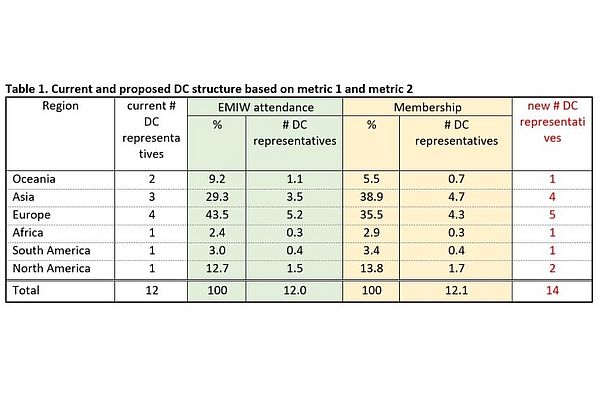Geographic representation

Principles
Requirements that must be addressed in the geographic representation scheme for the DC are as follows:
- The geographic representation scheme must provide effective geographic representation of the global electromagnetic induction community.
- The scheme must be updated when required, e.g. when the DC membership no longer provides effective geographic representation of the global electromagnetic induction community.
The proposed geographic representation scheme
The proposed scheme is based on objective metrics for the level of involvement in the activities of IAGA Division VI. Our definition of the global geographical regions (Appendix 1) uses the United Nations (UN) Geoscheme since IAGA is ultimately derived from UN bodies. With several small exceptions the previous and future practice of the DC adheres to this scheme. The exceptions are: (i) North and South America are considered as separate global regions rather than a single region, (ii) Central America and the Caribbean are included with North America to provide a greater number of countries in that global geographic area. And (iii) Turkey and Cyprus are included in Southern Europe rather than western Asian. However, some consideration may be given to adopting a fully compliant UN Geoscheme representation the next time the geographic representation is examined.
Metrics for involvement in Division VI activities
There are two possible metrics that can be used in this analysis to define the level of involvement of a country in Division VI activities (see Appendix 2):
- Attendance at the last three workshops (2012 in Darwin, 2014 in Weimar, and 2016 in Chiang Mai). The data come from the delegate lists for the three EMIWs.
- Current membership of Division VI as defined by those who have requested membership through the Division VI EMIW web page or qualified through attendance at a recent EMIW and who otherwise qualify for membership. These data comes from the Division VI webmaster as of June 7th, 2018.
Neither metric is a perfect measure but in combination they can define the framework conditions for the required regional representation within the DC. Thereby, the EMIW attendance may be skewed by the location of the particular workshops considered since participation from the same or neighbouring countries facilitate attendance. However, the data appear to reflect longer term trends in EMIW attendance reasonably well. The current membership through the EMIW.org database on the other hand might be biased towards more IT-affine countries.
Analysis
Table 1 shows the level of representation under the current membership of the DC (second column). Green columns show the results according to metric 1, yellow columns according to metric 2, respectively. Using both metrics as framework conditions and allowing a minimum representation of one DC member, the last column shows the proposed regional representation on the DC.
Transition to the new geographic representation scheme
To setup the DC according to the new geographic representation scheme and the result of the last division ballot, we have asked Stephan Thiel, one of the present Oceania representatives to become a Member-at-Large and continue to serve the rest of his normal term on the DC as treasurer.
An election will be held for a new representative:
(i) from North and Central America with nominees from Canada being ineligible because a continuing DC member comes from Canada.
(ii) from Asia (nominees from Japan, China and India being ineligible because of same reason as for (i) ).
(iii) from Europe (nominees from Russia, Spain, Germany & Poland being ineligible because of the same reason as for (i) ).
In the future, the DC will calculate similar representation charts prior to each workshop to be able to respond adequately if necessary. The results will be available from the EMIW web pages.
(last modified: April, 23rd 2019)
